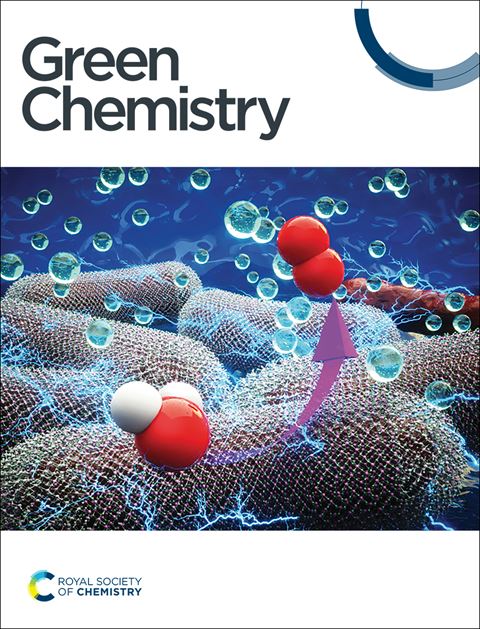Discovery and green metabolic engineering of a self-sufficient genistein pathway in Paenibacillus jilinensis†
IF 9.2
1区 化学
Q1 CHEMISTRY, MULTIDISCIPLINARY
引用次数: 0
Abstract
Genistein, a plant-derived isoflavone with pharmaceutical value, is conventionally obtained through ecologically detrimental extraction processes that rely on large-scale plant harvesting and hazardous solvents. Here, we report the discovery of native genistein biosynthesis in the Paenibacillus jilinensis, which inherently produces 5.7 mg L−1 genistein via the phenylalanine branch of the phenylpropanoid pathway. This pathway mirrors plant flavonoid synthesis but operates through seven bacterial enzymes (PjPAL, PjC4H, Pj4CL, PjCHS, PjCHI, PjIFS, and PjHID) with about 30% sequence homology to the corresponding protein sequences in plants, suggesting evolutionary convergence. To leverage this native capability for sustainable production, we constructed a genome-scale metabolic model (GSMM YPG26) with 1636 reactions and 717 genes to rationally optimize carbon flux. Metabolic engineering elevated genistein titers by 9.3-fold to 52.8 mg L−1 without introducing heterologous plant genes. Green-chemistry analysis further showed that P. jilinensis-ΔGLN achieves 92% less waste than soybean extraction and up to one order of magnitude better than state-of-the-art E. coli and yeast systems. It is crucial that this bacterial platform requires only a basic culture medium for sustained production, and eliminates dependence on medicinal plants. Our findings reveal P. jilinensis as a naturally gifted genistein producer and a green chassis for industrial isoflavone synthesis, aligning with green chemistry goals of waste prevention and bio-based process innovation.

吉林芽孢杆菌染料木素自给通路的发现及绿色代谢工程
染料木黄酮是一种具有药用价值的植物衍生异黄酮,通常通过依赖于大规模植物收获和有害溶剂的生态有害提取过程获得。在这里,我们报道了在吉林芽孢杆菌中发现的天然染料木黄酮生物合成,它通过苯丙氨酸途径的苯丙氨酸分支固有地产生5.7 mg L−1染料木黄酮。该途径反映了植物类黄酮的合成,但通过7种细菌酶(PjPAL、pj4h、Pj4CL、PjCHS、PjCHI、PjIFS和PjHID)运作,序列与植物中相应的蛋白序列同源性约为30%,表明进化趋同。为了利用这种天然的可持续生产能力,我们构建了一个包含1636个反应和717个基因的基因组尺度代谢模型(GSMM YPG26)来合理优化碳通量。在不引入外源植物基因的情况下,代谢工程将染料木素滴度提高了9.3倍,达到52.8 mg L−1。绿色化学分析进一步表明,P. jilinensis-ΔGLN比大豆提取少92%的废物,比最先进的大肠杆菌和酵母系统好一个数量级。至关重要的是,这种细菌平台只需要基本培养基即可持续生产,并且消除了对药用植物的依赖。我们的研究结果表明,吉林紫杉是天然的染料木黄酮生产者和工业异黄酮合成的绿色底盘,符合绿色化学目标的废物预防和生物基工艺创新。
本文章由计算机程序翻译,如有差异,请以英文原文为准。
求助全文
约1分钟内获得全文
求助全文
来源期刊

Green Chemistry
化学-化学综合
CiteScore
16.10
自引率
7.10%
发文量
677
审稿时长
1.4 months
期刊介绍:
Green Chemistry is a journal that provides a unique forum for the publication of innovative research on the development of alternative green and sustainable technologies. The scope of Green Chemistry is based on the definition proposed by Anastas and Warner (Green Chemistry: Theory and Practice, P T Anastas and J C Warner, Oxford University Press, Oxford, 1998), which defines green chemistry as the utilisation of a set of principles that reduces or eliminates the use or generation of hazardous substances in the design, manufacture and application of chemical products. Green Chemistry aims to reduce the environmental impact of the chemical enterprise by developing a technology base that is inherently non-toxic to living things and the environment. The journal welcomes submissions on all aspects of research relating to this endeavor and publishes original and significant cutting-edge research that is likely to be of wide general appeal. For a work to be published, it must present a significant advance in green chemistry, including a comparison with existing methods and a demonstration of advantages over those methods.
 求助内容:
求助内容: 应助结果提醒方式:
应助结果提醒方式:


